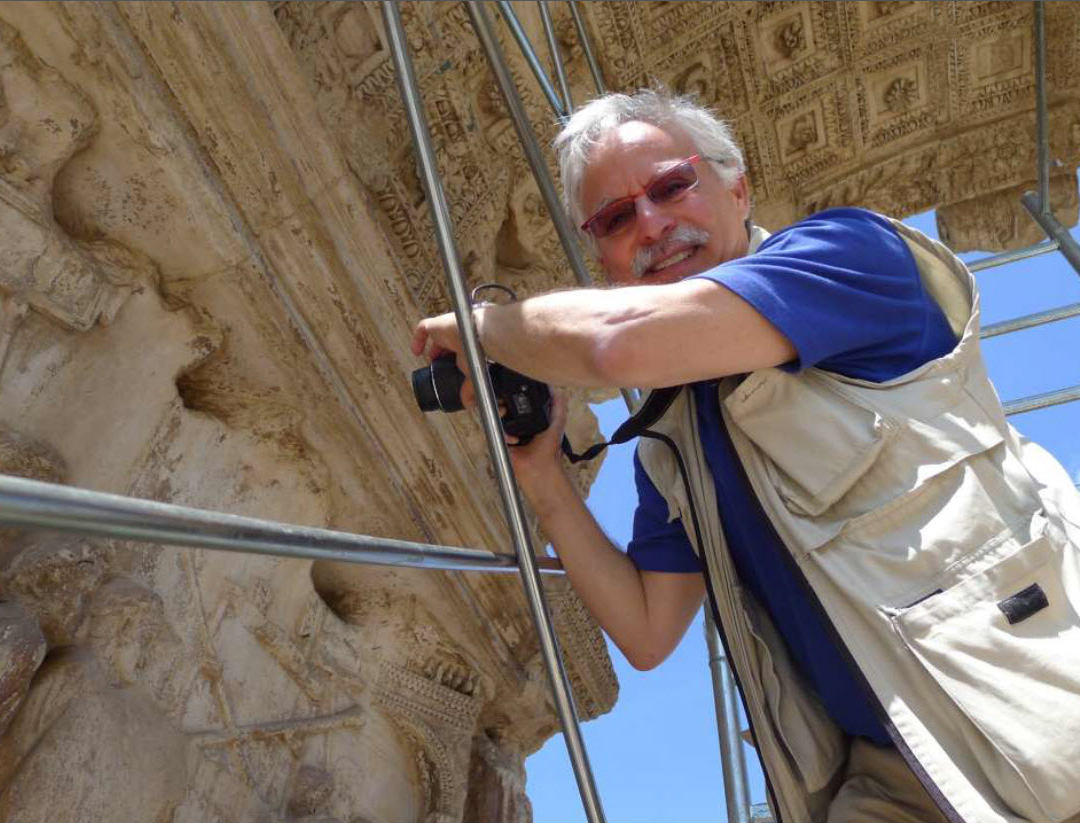Historians and archaeologists have studied the ruins of the Roman Forum for centuries, employing the tools on hand to add to the knowledge of this center of Roman public life that hosted elections, triumphal processions, speeches, trials, shops and gladiatorial spectacles.
The latest research suggests these structures, which we know as white marble, may have been brightly painted.
Bernard Frischer, a classics and art history professor in the University of Virginia's College of Arts & Sciences, led a team of experts who used cutting-edge technology to find traces of yellow pigment on a bas-relief of a menorah on the forum's Arch of Titus. In its heyday, the yellow pigment would have appeared gold from a distance.
Frischer said the menorah has historical significance. "The menorah on the relief is extremely important to Jews, since it shows the menorah from the Second Temple in Jerusalem, which Titus captured and sacked in A.D. 70."
Exposed to the elements for centuries, today no traces of pigment are visible to the naked eye. The arch was cleaned and restored in the 1820s. "For all we knew, any surviving pigment had been scraped off the marble, as has happened all too often in the past with other monuments and statues," Frischer said. A 1999 study "found plenty of discoloration owing to pollution, but no traces of ancient pigment."
Frischer, co-director for technology of the "Arch of Titus Restoration Project," headed by Steven Fine at Yeshiva University in New York, brought together experts for a pilot project – to use 21st-century technology to seek any remaining traces of pigment.
"This entailed the use of two different technologies with which I am very familiar from earlier projects," Frischer said.
The consultants used non-invasive, 3-D optical data capture and ultra-violet visual spectrometry to determine the chemistry of the pigment deposits. Frischer called on the expertise of Unocad of Vincenza, Italy for the 3-D capture using the Breuckmann smartSCAN for its precise optical measurements, and Heinrich Piening, a conservator with the State of Bavaria Department for the Conservation of Castles, Gardens and Lakes in Germany and a pioneer in ultra-violet visual spectrometry, for analysis.
"UV-VIS spectrometry is still a relatively new technique in Roman archaeology," Frischer said.
Frischer has applied cutting-edge technologies in creating 3-D digital models for polychromy restoration of Roman figures, such as the Virginia Museum of Art's statue of Caligula, on behalf of the Virtual World Heritage Laboratory, [link: http://vwhl.clas.virginia.edu/] which he founded in July 2009. The laboratory is administered by the classics department and hosted by the art department.
The Arch of Titus project findings will also add another dimension to his lab's virtual "Rome Reborn" [link: http://www.romereborn.virginia.edu/] project, a digital recreation of Rome as it appeared in A.D. 320. Frischer directs that ongoing effort, which was created by an international team of experts and launched in 2007.
Following final studies of the arch, Frischer will use the data to oversee two 3-D digital recreations for the Arch of Titus Restoration Project.
"In the first, or 'state model,' we will add just the color that is attested by Dr. Piening's studies," he said. "In the second, or 'restoration model,' we will go beyond the spotty evidence that survives to restore color all over the arch, inspired both by the actual traces and by analogous examples of painted Roman imperial monuments.
"What has been learned thus far can encourage even 'minimalists' like myself to dare to restore color even to monuments that have not yet been studied. After all, the ancient color palette was limited, and we are starting to see conventions emerge in the use of color. And one thing we do know is that white marble – whether on a public building or on a statue – was rarely, if ever, left unpainted."
From Ancient Greece until the 21st century, the arts and sciences have moved in tandem in an implicit and unconscious way, Frischer said.
"Today, the unity of art, science and technology is rapidly becoming a conscious theme as we embrace interdisciplinarity and unity of knowledge derived from concurring conclusions from a variety of disciplines in which the knowledge and expertise of different, seemingly unrelated fields such as archaeology, history, chemistry and physics can converge to give a better understanding of both the human and natural worlds. I see the Arch of Titus project as a good case in point."
– by Jane Ford
Media Contact
Article Information
June 28, 2012
/content/new-scientific-technologies-help-us-better-understand-ancient-rome

